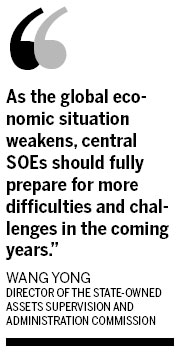Weak economy hurts profits of SOE listed units
The central government's State-owned enterprises have reported profit declines in 2011 for their listed units, and the weak global economy means further red ink for such companies, analysts said.
Among the 283 listed units of central SOEs, 203 have released 2011 results, according to the Shanghai-based market research provider Wind Information Co Ltd.
The companies' total revenues rose 23.9 percent to 9.07 trillion yuan ($1.4 trillion), while aggregate net profit fell 3.8 percent to 406.9 billion yuan.
"As the global economic situation weakens, central SOEs should fully prepare for more difficulties and challenges in the coming years," said Wang Yong, director of the State-owned Assets Supervision and Administration Commission.
The results statements show that the listed units saw rapid increases in finance, administration and sales costs last year. Financing costs rose 27 percent and labor costs increased 19 percent.
Prices for raw materials have been at high levels since last year, resulting in rising cost pressure.
"Continued high domestic inflation will undoubtedly lead to increased production costs for central SOEs, as prices of raw materials jump," said Li Yiqun, division chief of the emerging industry research institution of SASAC Research Center.

Inflation as measured by the consumer price index was a higher-than-expected 3.6 percent in March, compared with 3.2 percent in February, renewing concerns about inflationary pressures in the coming months.
The figure may push the government to adopt a more cautious stance on monetary easing and stimulus measures despite cooling economic growth, analysts said.
The government's inflation target for the year is 4 percent.
"To offset the impact of global economic weakness, major developed economies are accelerating structural reform, developing emerging industries and striving to find new economic drivers.
"This makes central SOEs' development reform more urgent," Wang said.
SASAC has been pushing SOEs to accelerate full stock market listings as a means of driving reform.
So far, 43 out of 117 central SOEs have fully listed. The other 74 have only floated some subsidiaries.
Shao Ning, deputy chief of SASAC, said the main trend of central SOEs' reform lies in market-oriented operations, which will help them become more globally competitive.
Through rationalization and the IPO process, the number of central SOEs has been reduced to 117 from the 196 that existed in 2003 when the commission was established.
The entire SOE sector has been experiencing a downturn this year.
Central and provincial SOEs as a group saw their first profit decline, along with the slowest revenue growth since 2009.
In the first two months of 2012, SOEs made total profits of 363.5 billion yuan, down 10.9 percent year-on-year, according to data from the Ministry of Finance show.
baochang@chinadaily.com.cn
(China Daily 04/13/2012 page14)








